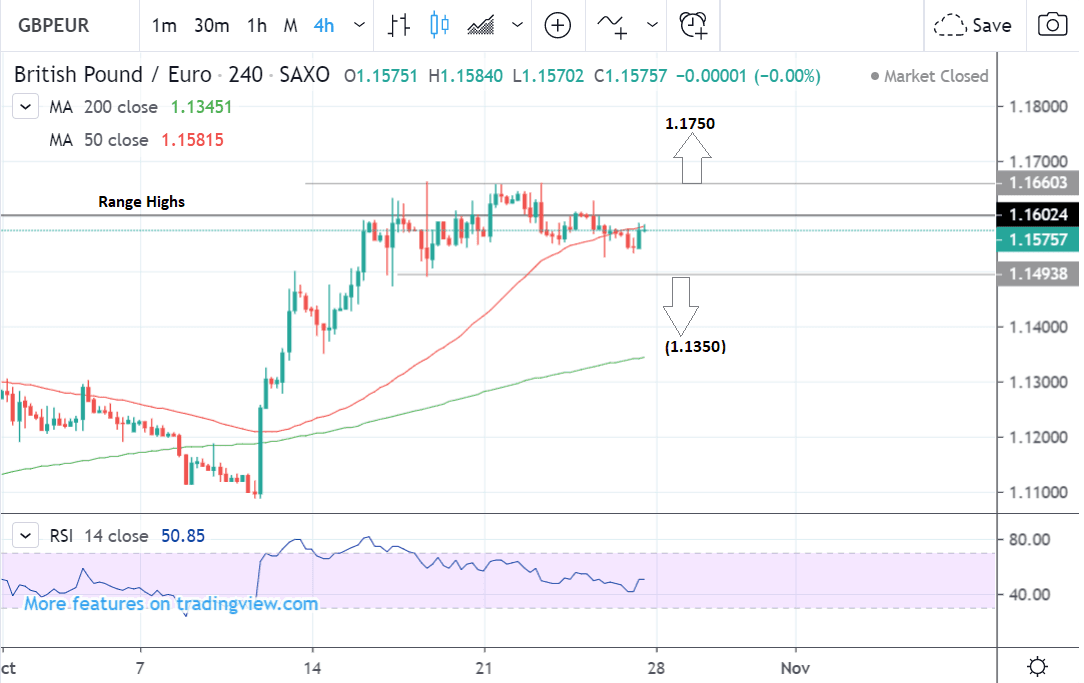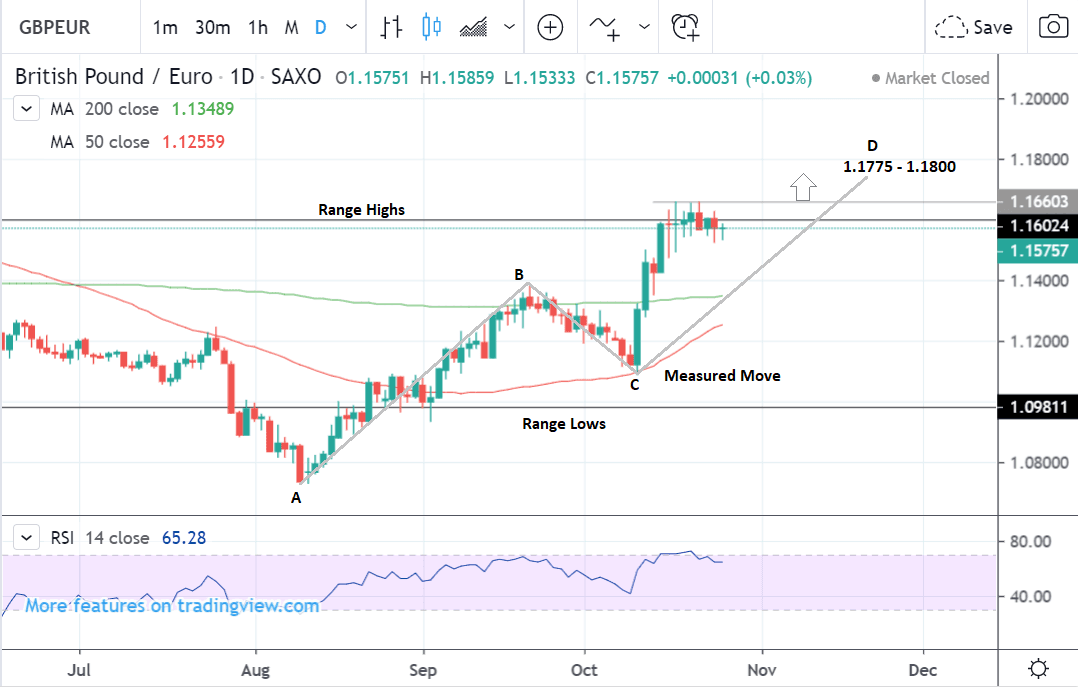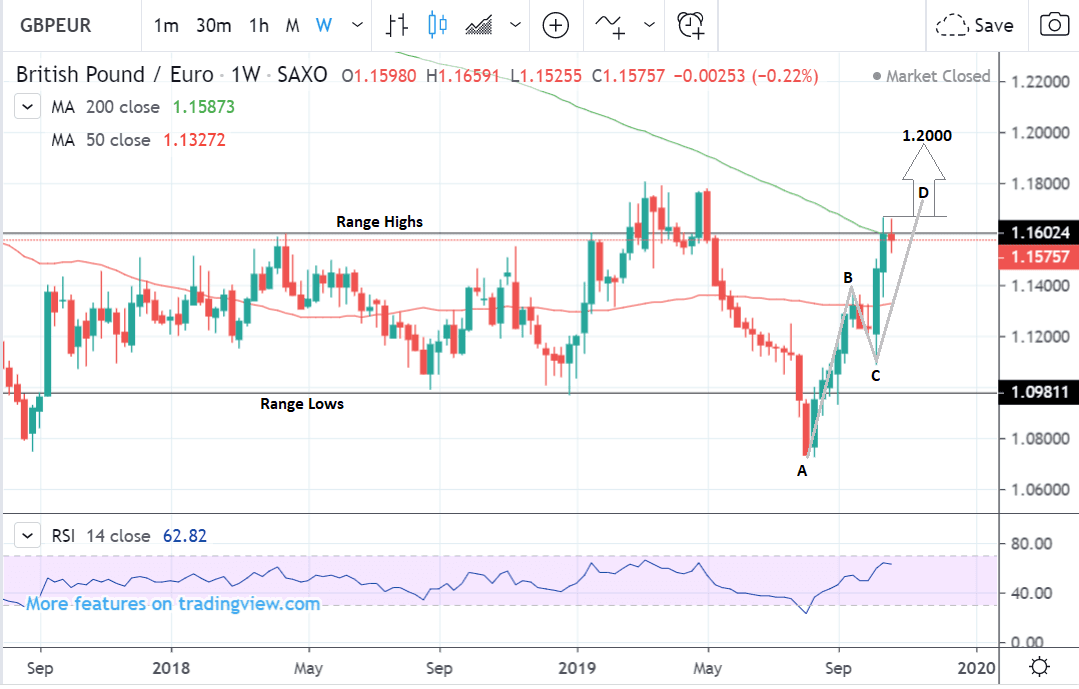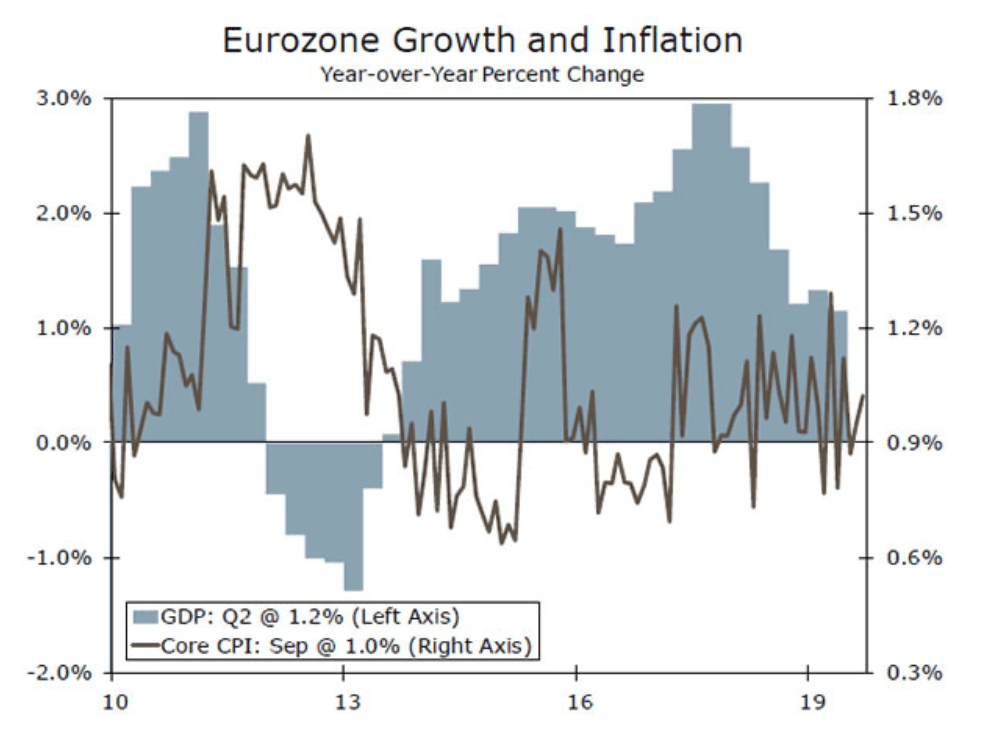Pound Sterling vs. Euro Week Ahead Forecast: Potential Target at 1.1750 if Resistance Breaks

Image © Adobe Images
- GBP/EUR enters in sideways range
- Technical resistance likely to cap advances
- EU to deliver Brexit extension verdict this week
- Euro eyes Eurozone GDP
The Pound-to-Euro exchange rate starts the new week at 1.1575, after falling -0.22% during the week before. Studies of the charts show the pair has reached a ‘glass ceiling’ that has applied the brakes to a multi-week rally and further upside is subject to a break of this resistance.
The 4 hour chart - used to determine the short-term outlook, which means the coming week - shows how the pair continues to trade sideways at the top of the long-term range at around 1.1600.
These highs are likely to act as an obstacle to further gains and there is a possibility of pull-back down within the range. However, a break above the 1.1661 October 17 highs would provide confirmation of a move up to a target at 1.1750.
A break lower, confirmed by a move below the 1.1490 range lows would probably confirm a continuation down to a target at 1.1350.
The daily chart suggests the potential for more upside.
GBP/EUR may have formed a bullish ‘measured move’ or ‘ABCD’ pattern, which is a three-wave zig-zag pattern higher.
These patterns are useful for forecasting purposes as the first (A-B) and third (C-D) waves are often of equal length, so the length if A-B can help predict the length of C-D.
In the case of GBP/EUR such a calculation suggests an endpoint at 1.1775 - 1.1800.
A clear break above the range highs, confirmed by a move above 1.1661, would be a necessary prerequisite for achieving the target.
The daily chart is used to analyse the medium-term trend, which is the next week to a month of price action.
The weekly chart shows the pair has reached resistance from the 200-week moving average (MA) and the range highs.
The combination of these two elements is quite strong and only a clear break above the 1.1661 highs would provide confirmation of a breakout and continuation higher.
Such a move, followed by further breaks such as above 1.1800, could eventually see an extension of the uptrend, over the long-term to a target of, perhaps, 1.2000.
The weekly chart is used to analyse the long-term trend, defined as the next several months of market action.
Time to move your money? Get 3-5% more currency than your bank would offer by using the services of a specialist foreign exchange specialist. A payments provider can deliver you an exchange rate closer to the real market rate than your bank would, thereby saving you substantial quantities of currency. Find out more here.
* Advertisement
The Pound: EU Decision on Brexit Extension Key

This was supposed to be the week the UK left the EU, instead politicians will be left strategising around a Brexit extenions, the length of which could determine whether the Government takes another crack at passing Brexit legislation or pushing for a General Election.
The Pound is however likely to remain supported in the week ahead as the chances of a ‘no-deal’ Brexit remain negligible whilst other outcomes - successful implementation of the government’s deal, a general election, and a referendum - are all relatively benign from Sterling's standpoint.
Monday could be the day the EU will announce the length of the Brexit extension, however resistance from France to a lengthy delay are making EU discussions on the matter more protracted than might be expected.
France see little reason to grant a long extension because the UK are not offering any credible reason for such a delay: recall the EU have consistently said a delay will only be considered were the UK to hold elections or a referendum.
If a long delay is agreed, to January 31, Prime Minister Boris Johnson will push hard for an election, but he needs a two-thirds majority in Parliament to do that, which would require the support of the Labour party, which is currently undecided.
Labour leader Jeremey Corbyn has expressed concern that if he supported a general election it would lead to parliament being dissolved and could open the door to the government delivering a hard-Brexit ‘by stealth’ in the interim. He says wants assurances from Johnson that a ‘no-deal’ could never happen, before giving his backing to a general election.
However, the sceptic would point to Labour's dire polling for the hesitancy.
Either way, markets have taken a bullish stance on Sterling when the odds of Johnson's deal passing rises, and it falls when those odds fall.
"We see prospects of an early election as negative for GBP given that it would tame optimism about the withdrawal agreement being reached – the key driver of GBP gains this month – and reintroduce uncertainty into Sterling," says Petr Krpata, a foreign exchange strategist at ING.
More delay and uncertainty surrounding an election are likely to on balance have a bearish impact on Sterling.
On the economic data front, the most important release is Manufacturing PMI for October out on Friday at 10.30 BST and forecast to show a fall to 48.1 from 48.3.
The PMI is a survey-based gauge of sentiment and activity in the sector under examination. The improved mood music around Brexit and global trade means there is a risk of a slightly better result lending Sterling mild support.
Expect economic releases to play second-fiddle to Brexit developments.
The Euro: What to Watch

The main fundamental drivers of the Euro in the short-term are GDP, inflation and unemployment data, all out on Thursday.
Eurozone GDP is forecast to rise by 0.1% in Q3 compared to Q2, and 1.1% compared to a year ago when it is released at 11.00 BST.
This represents a slower pace than Q2 when growth was 0.2% on a quarterly basis and 1.2% yearly.
“The Eurozone economy has struggled for the past several quarters, something we expect continued in Q3, where we forecast growth of just 0.1% quarter-over-quarter,” says Wells Fargo.
GDP is a key factor in currency evaluation and a higher-than-expected reading should be taken as positive or bullish for the Euro, while a lower-than-expected reading should be taken as negative or bearish for the Euro.
Another key release for the Euro is inflation or CPI data, which is scheduled to be released at the same time as GDP.
CPI is forecast to rise 0.8% in October and core CPI, which leaves out volatile fuel and food components, by 1.0% in October.
Though often characterised as an economic bugbear, in an economy blighted by slow growth, higher inflation is a sign of increased demand and is seen as positive.
A higher-than-expected reading is therefore positive for the Euro and vice versa for a lower-than-expected reading.
Given current low forecasts, the overall trend appears to be for lower inflation which could lead the European central Bank (ECB) to step in with more stimulus - something which is negative for the Euro.
“With economic growth slow and inflation modest, expect further ECB monetary easing in the months ahead,” says Wells Fargo.
The final release of importance for the Euro is Eurozone unemployment, which continues to decline, albeit at a slower pace than before.
Forecasts are currently for unemployment to remain stuck at 7.4% in September, however, a fall to 7.3% might be possible and could help support the Euro marginally.
Time to move your money? Get 3-5% more currency than your bank would offer by using the services of a specialist foreign exchange specialist. A payments provider can deliver you an exchange rate closer to the real market rate than your bank would, thereby saving you substantial quantities of currency. Find out more here.
* Advertisement








